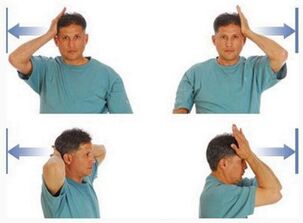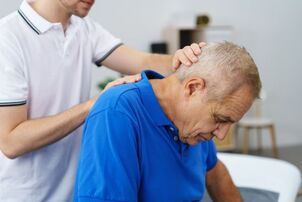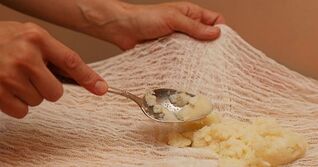Osteochondrosis can develop in any part of the spine, but most often it affects the neck and spine. This disease is inflammatory-dystrophic in nature and usually takes a chronic form. Cervical osteochondrosis is more commonly diagnosed in women, while men are more prone to lumbar spine osteochondrosis.
General Description
Most people today sit in a sitting position: at school, college, office, driving a car or at home with a computer. Over time, many people experience an uncomfortable feeling after a long sitting, and then pain. Posture deteriorates, deviation occurs, it is difficult to straighten or reverse.
Thus emerges 1, the initial stage of osteochondrosis, in which the disease is the easiest to treat. If you do not take action, in the future it threatens the chronic form with regular exacerbations. In some cases, the case ends in disability.
Indication: Cervical osteochondrosis is half of all pathologies.
The clinical picture of cervical chondrosis includes:
- Pain syndrome caused by compression of nerve roots. Depending on which spine and disc is injured, the pain may spread to the shoulder, forearm, or the entire arm. Characterized by headaches, pressure waves;
- Sensory disorder, mainly in the hands and fingers. There may be numbness, a burning sensation, or a tingling sensation;
- Decreased muscle strength and tone, sometimes with muscle tremors and cramps;
- increased sweating, skin discoloration - pale, red;
- chest pain; Spinal artery syndrome occurs when one of the two arteries stretches, accompanied by severe headache, tinnitus, nausea, dizziness, and less often, swallowing disorder.
There are no medications that can completely eliminate the cause of osteochondrosis. But you can get rid of its symptoms and prevent possible relapses using the simplest methods.
How is chondrosis treated?
In the acute phase, it is rare for anyone to go without pain medication. The most popular and effective are inexpensive drugs based on sodium metamizole, as well as nonsteroidal anti-inflammatory drugs - nonsteroidal anti-inflammatory drugs.
In case of severe pain, the attending physician may prescribe analgesics for injections, but more often they are prescribed in tablets and supplemented with ointments. Complex therapy includes physiotherapy, massage and exercise. Massage sessions and therapeutic exercises usually begin after the acute symptoms have subsided.
What you can do in your own home
Treatment of cervical osteochondrosis is a prerequisite that most doctors claim. It is impossible to cure the disease only with medication and physiotherapy, they only temporarily relieve the symptoms. The remission period can be extended with regular, dosed physical activity, the use of self-massage techniques, therapeutic compresses, and strengthening infusions.
Impressive results can be achieved by following exactly the instructions and following the medical advice. Self-massage significantly saves finances, the use of decoctions and herbal infusions, instead of some remedies, reduces the negative impact of medications on the body.
Home therapy, like traditional treatments, helps to quickly stop the pain syndrome, normalize cerebral circulation, and improve sleep. With the help of available products you can eliminate nervousness and irritation, stabilize blood pressure, restore normal sensitivity of the neck and neck region.
Exercise Therapy
Therapeutic exercises are included in the main standard for the treatment of neck chondrosis and are selected by the exercise therapy instructor. The first 1-2 sessions are held in a polyclinic or health center, and then the patient can train himself at home.
Exercise 1. PI (starting position) - standing, feet shoulder-width apart. Lean your head to the right, left, front and back. All movements should be slow and smooth, be especially careful to pull yourself back, not suddenly throw yourself back.
Exercise 2. Turn the pages from the same PI. At the extreme point, look back. Sometimes at first you can not turn your head too much and you should not force events. Over time, the "block" movement will disappear.
Exercise 3. Take your shoulders back, bring your shoulder blades as close as possible. Hold this position for a few seconds, then bring your shoulders forward and bring your back back. The movement is similar to the famous "cat", but takes place in a standing position.
Another effective set consists of the following exercises:
- standing or sitting, put your hands on your forehead and press your head on them, overcome the resistance of your hands. Hold this position for 15-20 seconds.
- Place your hands on the back of your head, pressing your back against your hands and the back of your hands.
- Place the palm on the right ear and apply mutual pressure, trying to bend the head towards the right shoulder. Then switch sides and place your head on your left shoulder, placing your left hand on your left ear.
- Turns the pages, placing the palm on the left or right cheek. First, the hand rests on the right cheekbone while the head tries to bend to the right to overcome the resistance of the hand. Then the palm rests on the left cheek while the head turns to the left. Pressure time is 15-20 seconds.
- Hold the lower part of the head with the fingers on the chin and the rest on the back of the head. Gently run your head up, allowed to spin from side to side as "pulling the cork out of the bottle". You can not turn your head, the cervical spine must be straightened. The duration of the exercise is 15-20 seconds.
- Spread your arms out to the sides and turn first to the left, then to the right, and then to both sides. This exercise is especially useful for those who feel tension in the neck and shoulder area.
- Standing on your feet or with your back straight, "extend" your back from left to right and in the opposite direction, bend it as much as possible in the middle and reach the chest with your chin. The number of repetitions is 10-12.

It is not necessary to complete the above complex if some exercises cause pain and severe discomfort. As agreed with your doctor, you can additionally hang on a horizontal bar or strip, go swimming, water aerobics and other permitted sports.
Self-massage
Self-massage helps treat cervical osteochondrosis at home. Gentle pressure on the neck prevents salt deposits, improves blood supply and tissue nutrition, and reduces pain intensity. During the procedure the muscles are relaxed, metabolic processes are accelerated, blood pressure is stable.
If you wish, you can visit a masseur at a therapy clinic or undergo procedures at home. However, it is convenient to massage the neck on your own, learning the basic techniques and determining the points that need to be worked out. It is also important to know which zones are best to do, or to act on them carefully.
Massage technique is quite simple and it is quite possible to master it. The basic rules are:
- The direction of movement is from the center to the periphery, ie from the spine to the shoulders and back of the head;
- It is permissible to massage the cervix only with the fingers, without the use of any apparatus;
- Strong pressure is out of the question: you have to act delicately and gently;
- The muscles of the back and side muscles are broken, torn, and stretched;
- massage is held in a sitting position;
- The session begins with a kick, continues with swinging and onion movements, and also ends with a stroke;
- The duration of the procedure is 5-10 minutes.
You can use the Kuznetsov applicator without contraindications and without the approval of the attending physician. This affordable and efficient device is a roller made of fabric or oil cloth with elevated elements - round or square pointed plates.
The applicator is easy to use - just insert it and lie on it. Soft needles bite into the skin, increasing blood flow and acting on biologically active points in the neck. The duration of the procedure starts from a few minutes and gradually increases.
First aid for exacerbations
If cervical lumbago occurs suddenly, the ideal solution is to visit a doctor or call a specialist at home. In case of delayed assistance, a number of measures should be taken to alleviate the pain and protect it from possible damage to the spinal structures.
Convenient position
First of all, you need to secure the cervical spine and limit physical activity as much as possible (it is better to exclude it completely). You lie on a flat and moderately solid bed or on a thick blanket on the floor. Very hard floors, such as bare plank floors or airy feather beds, will not work.

In severe neck pain caused by osteochondrosis, it is recommended to wear a shunt collar to prevent the neck from moving or turning freely. This will reduce the load on the cervical muscles and improve local blood circulation.
If you do not have a shunt collar, you can make a handmade tire out of cardboard and cotton to straighten your neck.
Tip: Do not use heating gums or ointments, rub your neck before going to the doctor. In some cases, such actions can lead to very unpleasant complications.
Local funds
Ice or cold compresses may be applied during the first hours of the attack, but there should be a layer of cloth or gauze between them and the body. This will prevent hypothermia and pain.
Anti-inflammatory and analgesic ointments and gels based on diclofenac, ibuprofen, nimesulide and indomethacin may be used. The use of products such as Finalgon, Viprosal, Capsicam and other preparations with combustion components in the composition is prohibited.
Warming ointments and rubs have a local irritating effect, increasing blood circulation to the neck, which may increase swelling and contraction of nerve endings. Special care is needed in the cervical spine, as improper actions are accompanied by a sharp rise in blood pressure.
In case of exacerbation of osteochondrosis, massage is not performed because of the increased pain and the risk of reflex muscle spasms. In addition, the cervical spine is hypermobilized and any careless movement can worsen the condition.
Medications
Pain can be treated with medication, but remember that pain is a protective mechanism. When it is forcibly eliminated, nothing can stop you from moving sharply, which will make the condition worse. Therefore, after taking the painkiller should follow a gentle and preferably bed rest for at least 2-3 days.
Severe pain, which does not mean stopping the pill and intramuscular injection, is relieved with the help of novocaine blockade. This procedure is done strictly in a hospital setting: a local anesthetic is injected next to the injured spine and blocks the pain. Blockade is carried out only according to the indications and can cause side effects in the form of allergic reactions and infectious complications.
Prohibited Actions
Acute neck pain is a good reason to consult a doctor and have a comprehensive examination. Only after making an accurate diagnosis are the treatment tactics and the most effective methods in a particular case determined.
It is categorically impossible to relieve pain in any form - for example, try to correct a displaced spine, or refer to a friend who is not a specialist. Do not take large doses of painkillers uncontrollably. Even folk remedies can be harmful if the diagnosis is not yet known.
Proper movement regime is very important: if during the aggravation phase the movements should be limited as much as possible, after a few days the physical activity should be expanded. Exercise from a complex of exercise therapy will help improve blood circulation, reduce the intensity of pain and reduce the inflammatory process. In addition, properly selected exercises will help strengthen the muscle corset that supports the spine.
How to Cure Osteochondrosis Forever
Complex medical treatment consists of several groups:
- Nonsteroidal anti-inflammatory drugs and analgesics for exacerbations; Muscle relaxants for muscle relaxation;
- Chondroprotectors, cartilage tissue repair of intervertebral discs;
- Vitamin and mineral complexes containing B group vitamins
Various ointments, gels and varnishes - for example, Nanoplastic patch - effectively complement the treatment. Pharmacies today have a wide range of local remedies that can be used for both exacerbation and recovery:
- anti-inflammatory;
- Chondroprotective;
- Homeopathic.
Warmers may be used to reduce severe symptoms.
Traditional methods
Honey-potato wrap is made from raw grated potatoes and honey. Both components are taken in equal amounts, mixed and poured on a cloth or gauze. The compress is applied to the neck for about 45 minutes. The procedure is performed twice a week.

Wax or paraffin should be melted down and applied to the sore spot to avoid contact with the spine. Doing such programs is recommended once every two days.
Roll out the water and rye flour dough to medium density, roll out the cake and attach to the neck. Apply to skin with turpentine. Compress with polyethylene and a warm cloth, let stand until burning, but not more than 15 minutes. You can perform the procedure every other day.Herbal preparations for oral administration are made from the following ingredients, taken in equal proportions:
- chamomile;
- yarrow;
- St. John's wort;
- calendula;
- thiam;
- dandelion leaves.
2 st. Boil the mixture in a thermos, pour it into one liter of boiling water. Take 3 times daily before meals for a glass.
Thus, at home, you can do many things to get rid of such a nasty disease as osteochondrosis. With all medical appointments, including medication, physical and massage procedures, and therapeutic exercises, there is every chance of preventing its progression and preventing relapses.
What to do now
Statistics show that more than 45% of people over the age of 35 have joint diseases! It all starts small: somewhere they have outgrown themselves, somewhere they have gained weight, somewhere they have been blown up. The joint is designed so that the main problems start with inflammation of the joint fluid, then softening of the cartilage and, consequently, disability.
One important thing to remember: joint diseases can take you to a wheelchair in less than 3 years! The disease develops many times faster if you are overweight, since in this case there is a double load on the joints.














































